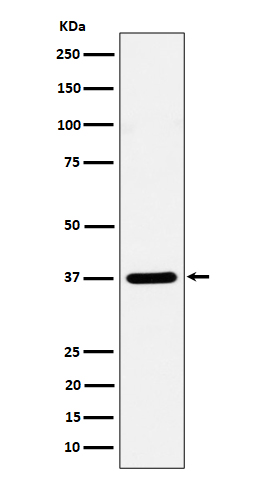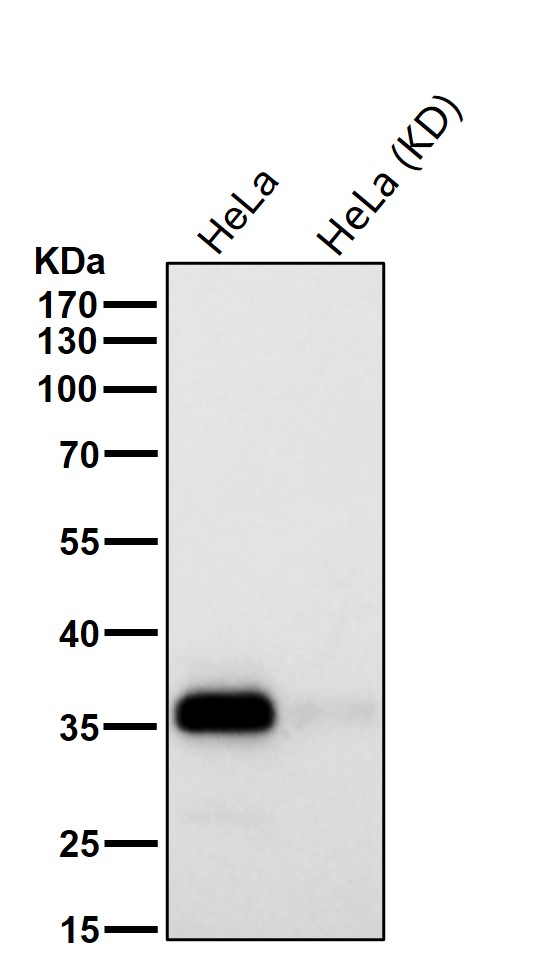

| WB | 咨询技术 | Human,Mouse,Rat |
| IF | 咨询技术 | Human,Mouse,Rat |
| IHC | IHC:1/100-1/200;IHF:1/50-1/200 | Human,Mouse,Rat |
| ICC | 1/50-1/200 | Human,Mouse,Rat |
| FCM | 咨询技术 | Human,Mouse,Rat |
| Elisa | 咨询技术 | Human,Mouse,Rat |
| Aliases | hsyn16; Stx16; Syn16;;Syntaxin 16 |
| WB Predicted band size | 37 kDa |
| Host/Isotype | Rabbit IgG |
| Antibody Type | Primary antibody |
| Storage | Store at 4°C short term. Aliquot and store at -20°C long term. Avoid freeze/thaw cycles. |
| Species Reactivity | Human,Mouse,Rat |
| Immunogen | A synthesized peptide derived from human Syntaxin 16 |
| Formulation | Purified antibody in PBS with 0.05% sodium azide,0.05% BSA and 50% glycerol. |
+ +
以下是关于Syntaxin16抗体的3篇参考文献,按文献名称、作者及摘要内容简要列出:
---
1. **文献名称**: "Syntaxin 16 regulates the segregation of apical and basolateral transport in epithelial cells"
**作者**: Fukuda, M., et al.
**摘要**: 研究探讨了Syntaxin16在上皮细胞极性运输中的作用,通过特异性抗体进行免疫荧光和Western blot分析,发现其参与调控顶端与基底侧膜蛋白的分选过程。
---
2. **文献名称**: "The role of Syntaxin16 in secretory pathway trafficking and autophagy"
**作者**: Wang, Y., et al.
**摘要**: 利用Syntaxin16抗体进行免疫沉淀和共聚焦显微镜观察,揭示了该蛋白在分泌途径与自噬体形成中的双重功能,尤其在肝癌细胞模型中的表达异常。
---
3. **文献名称**: "Syntaxin16 interacts with the Golgi SNARE complex and modulates intra-Golgi transport"
**作者**: Tai, G., et al.
**摘要**: 通过抗体介导的蛋白质敲低实验,证实Syntaxin16与高尔基体SNARE复合体的相互作用,调控内质网-高尔基体间的囊泡运输效率。
---
如需更多文献或具体应用场景(如特定疾病模型),可进一步补充关键词检索。
**Background of Syntaxin 16 Antibody**
Syntaxin 16 (STX16) is a member of the SNARE (soluble NSF attachment protein receptor) protein family, which plays a critical role in intracellular membrane trafficking and vesicle fusion. It is primarily localized to the Golgi apparatus and endosomes, where it facilitates cargo transport and membrane compartment dynamics. STX16 interacts with other SNARE proteins, such as Vti1a and Syntaxin 6. to mediate retrograde trafficking from endosomes to the trans-Golgi network, essential for maintaining organelle integrity and protein sorting.
Antibodies targeting Syntaxin 16 are valuable tools for studying its expression, localization, and function in cellular processes. They are widely used in techniques like Western blotting, immunofluorescence, and immunoprecipitation to investigate STX16’s role in secretion, autophagy, and receptor recycling. Dysregulation of STX16 has been implicated in pathological conditions, including neurodegenerative diseases and cancer, making its antibody a key reagent for exploring disease mechanisms.
Many Syntaxin 16 antibodies are raised against specific epitopes, such as the N-terminal or C-terminal regions, and validated for cross-reactivity in human, mouse, or rat models. Researchers rely on these antibodies to dissect STX16’s involvement in cellular pathways, its interaction partners, and its potential as a therapeutic target. Proper validation (e.g., knockout controls) ensures specificity, critical for accurate experimental outcomes in cell biology and biomedical research.
×